
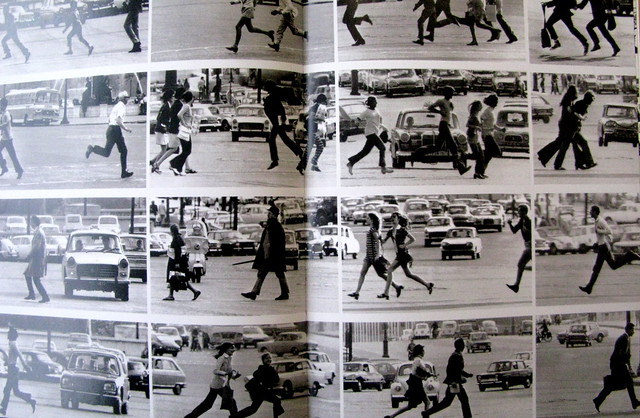
Robert Doisneau - running pedestrians in Paris
We recently covered the disturbing and archaeic 85th percentile method and how it is applied for (and by) vehicles. If you thought THAT was fun, you might also enjoy The 15th Percentile. It is frequently used to determine the time between the WALK and DON'T WALK crossing signals - in other words, how much time the engineers computer models allow for human beings to cross streets. It's not as rooted as a standard as The 85th Percentile, but it is still widespread.

In a nutshell, we should be paying more attention to pedestrian crossings, when you consider statistics that say that "40% of accidents involving pedestrians occur at these intersections". In Europe, one in four pedestrians die on a crossing. What seems to be the problem?
In the U.S., the Manual on Uniform Traffic Control Devices (MUTCD) establishes a “normal” pedestrian speed at 1.2 metres per second (m/s), so traffic signal times are set according to that speed. It is also an international standard. One of the first things that popped into my head was: “what about the most vulnerable groups such as children or the elderly?”.
After analysing several published studies, children didn't appear to be the most problematic group – at least when it comes to their crossing times. Instead it is the elderly that are a cause for alarm.The elderly have different 15th Percentile speeds than younger pedestrians, but it is still widely recognized that the the crossing time for older pedestrians is insufficient. In other words, 1.2 m/s simply isn't enough for older people to cross a street. Which, of course, means that it is not a very good standard, especially considering that our population is growing older and older. It's a standard that can lead to increaed death and serious injury.
Once again, we've made the mistake of allowing ourselves to be controlled by machines, like numbers. We know all too well that this has been proven to be insufficient in protecting pedestrians and cyclists, among others.
The fact that 1.2 m/s is not a speed for everyone has proved to be common knowledge. For instance, the Institute for Transportation Engineers is aware of the fact that "(...) the majority of traffic signals [in the U.S.] are timed so that up to half of pedestrians beginning to cross at the start of the clearance interval potentially will be in the street when conflicting traffic is free to proceed."
Even the MUTCD raised awareness about this by saying that a speed lower than 1.2 m/s should be considered when pedestrians with slower speeds routinely use crossings. So, if establishing a traffic signal time limit by the 15th percentile will give slower speeds than the average ones, the theory should be right, no? Then why are so many people getting injured or killed in the place where they should be protected the most - when crossing a road?
The simple answer: The 15th Percentile is still not enough to solve the problem for slower pedestrians.After watching a number of videos of intersections – pedestrian crossings and its failures – beyond the point of mental sanity, there are a few problems that can be addressed (among many others, I'm sure) and that seem to have failed:
- Confusing signals for pedestrians. In the U.S., 50% of pedestrians, don't understand that the red “Flashing Don't Walk” sign means that you may continue crossing. Of course they (including me) don't understand: it's because it is confusing. Farther down you'll find particular cases around the world.
- The stop line for cars is too close to the pedestrian crossings. This one goes without saying.
- Drivers running red lights. It's obvious but I don't understand how this still happens these days.
- Not every sign respects the average speed of the pedestrian. Let's admit for one second that the average speed is 1.2 m/s, regardless of the group of pedestrians. Not every pedestrian crossing signal respects that speed. How many of us had to almost run in some crossings just to arrive safely on the other side? There's also probably a lack of inspection going on in some cases.
- 0.9 m/s should be the speed set for the average pedestrian – according to previously cited studies. This would allow the accommodation of all types of pedestrian groups. Several studies (linked here, here and here) have also pointed out that this is the speed for older pedestrians.
- The time gap between the red signal for pedestrians and green one for cars should be much longer, in some cases.
- In the U.S., a crossing with some instructions for pedestrians. Without sounding paranoid, are we moving towards a mandatory walking licence?

- In Berkeley, California, an experimental program between 2001 and 2004 was set up to test the efficiency of pedestrian flags. We blogged about it before. The methodology was: before crossing, the pedestrian would pickup a flag and waved it while crossing; then he would leave it in situ after crossing. Here’s an image:
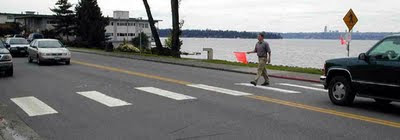 Whilst using pedestrians for any experimental program is quite disturbing, the program was rather unsuccessful. Here’s what went wrong: Nevertheless, other cities in the US have pedestrian flags in place. Seriously.
Whilst using pedestrians for any experimental program is quite disturbing, the program was rather unsuccessful. Here’s what went wrong: Nevertheless, other cities in the US have pedestrian flags in place. Seriously.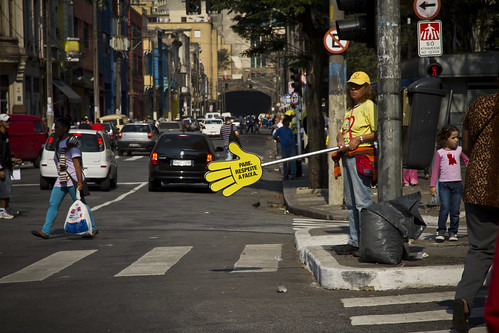 This is a very noble initiative but it still states clearly that the car rules the streets. Reducing car speeds would make this unnecessary.
This is a very noble initiative but it still states clearly that the car rules the streets. Reducing car speeds would make this unnecessary.
- On the other hand, let’s not forget the “push button” examples throughout the world:
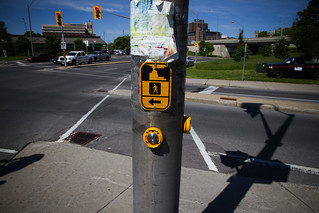

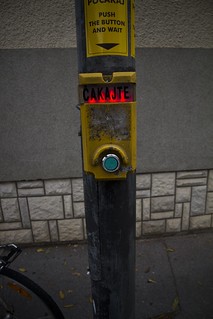
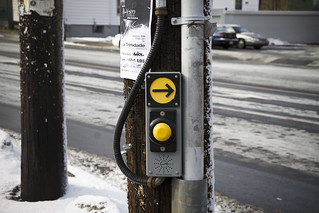
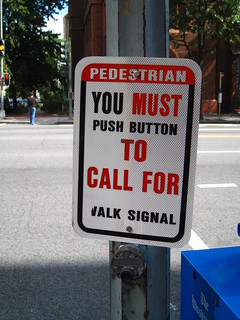 The last image is very peculiar. Not only the streets don’t belong to pedestrians but now we have to submit to the power of the car (“THOU SHALL NOT PASS”?). Generally, these pedestrian buttons (or even for cyclists like they have in the Netherlands), require human beings to push a button and wait for the mercy of an engineered computer programme to grant them permission to enter the roadway. When do you we ever require motorists to stop, roll down the window and press a button before crossing an intersection?
The last image is very peculiar. Not only the streets don’t belong to pedestrians but now we have to submit to the power of the car (“THOU SHALL NOT PASS”?). Generally, these pedestrian buttons (or even for cyclists like they have in the Netherlands), require human beings to push a button and wait for the mercy of an engineered computer programme to grant them permission to enter the roadway. When do you we ever require motorists to stop, roll down the window and press a button before crossing an intersection?
This recent news item from Stoke, UK shows how ridiculous some city councils can be. A spokesman actually says, "it was not that the crossing was not working properly, it was just that people were not using it correctly." So the council will hire people to stand in the crossing and "educate" pedestrians about how to use the badly designed crossing.
- Traffic signals for pedestrians:
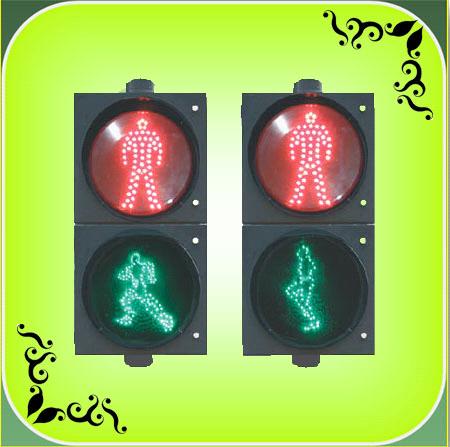 |
| (source: here) |
 |
| (source: here) |
 |
| (source: © Apple Record) |
But we still have an elephant in the room - a bull in the china shop - and the above measures are directed to avoid him while he's walking there. In this case, the elephant is the car – and the (almost) subsequent excess of speed by the driver. Reducing speeds in streets would help tackle pedestrian safety in a greater way. Also, citizens’ initiatives are the most powerful and effective work-force, in my opinion. They should have a bigger role, considering they are the biggest stakeholders when in comes to traffic safety.
At the end of the day, it's funny that there are engineers entirely responsible for the free flow of vehicular traffic movement, but we don't have the equivalent for pedestrians. Sure, engineers who should be responsible for the free flow of pedestrians. Including their safety, of course.
All in all, The 15th Percentile method doesn't seem that bad at first sight. However, it still fails to protect everyone due to the fact that the elderly are slower walkers. We're still making the same mistake as ever: thinking of people as numbers. They (we) aren't. But today's pedestrian crossings show that you have to be fit, be 100% aware, be literate. Basically, you have to be a "perfect robot" and adapt. Adapt to traffic, adapt to cars, adapt to signals and adapt to crossings. It's Darwin's natural selection: the survival of the fittest.PS: If you know any absurd activity on crossings for pedestrians, please share with us.





